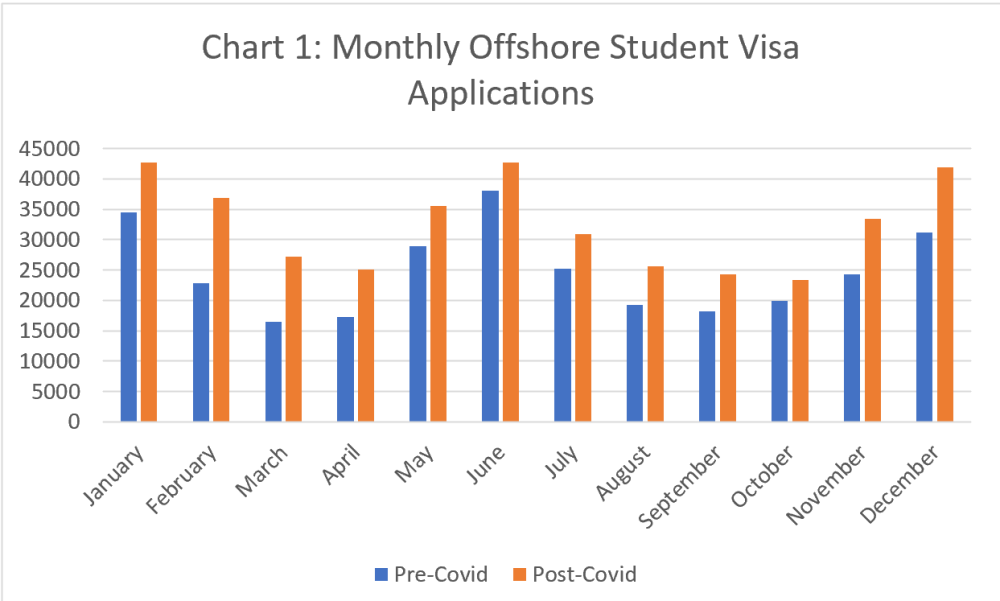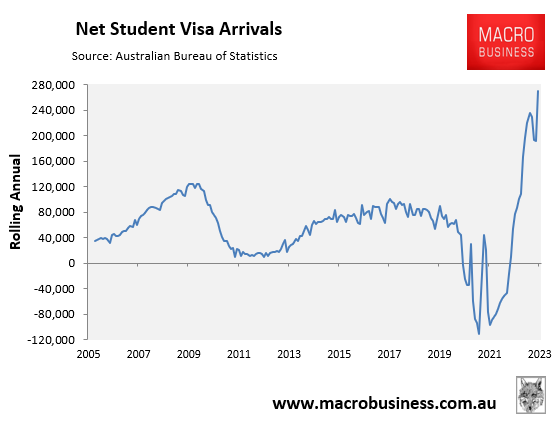Over the long weekend, Abul Rizvi tweeted that an unprecedented 96,578 onshore student visas were granted in November and December 2022, which was more than four times the previous record of 21,973 visas granted:

Rizvi also tweeted that a record 55,878 VET sector student visas were granted over the same period, which was around five times the previous record of 11,890:

Moreover, the Department of Home Affairs handed out visas like candy, “rubber stamping just about every application”:

In a separate article for Independent Australia, Rizvi warns that the unprecedented boom in international students “may end abruptly and in tears” with many students being left in “immigration limbo”.
Rizvi correctly argues that “the current boom in student visa applications lay in former Immigration Minister Alex Hawke’s decision to provide overseas students with unlimited work rights”.
This decision “not only trashed the reputation of Australia’s international education industry (Hawke was effectively saying you can get an Australian qualification without having to study very hard), but also provided education agents with an extraordinary marketing tool”.
“Hawke was responding to short-term pressure from business lobby groups demanding cheap labour rather than thinking about good long-term policy”, argues Rizvi.
As a result, “in every month post-COVID, offshore student visa applications have exceeded the pre-COVID all-time record by around 20%to 30%”:

“The number of student visa holders in Australia increased from 315,949 at end 2021 to 585,847 at end February 2023, an increase of over 85% in just 14 months”.
“Never before have student numbers increased at such a rapid rate”, says Rizvi.
“And there is no indication of this trend reversing. If anything, the extent to which the pre-covid records are being exceeded appears to be increasing”.
I will add that visa data from the Australian Bureau of Statistics shows that net student visa arrivals exploded to a record high 270,300 in the year to February 2023, which was more than double the previous record of 125,000 in mid-2009:

Thus, both onshore and offshore student visa grants are booming, which is driving Australia’s record net overseas migration and rental crisis.
However, it is wrong to only blame the former Coalition Government for the explosion in student visas given the Albanese Government used last September’s Jobs & Skills Summit to turbo-charge arrivals by:
- Extending the unlimited work cap by an additional year;
- Extending post study work rights for an additional two years; and
- Increasing the permanent migrant intake by 35,000 to a record high 195,000, thereby increasing the chances of students gaining permanent residency.
To his credit, Rizvi does mention that “both Hawke and subsequently current Education Minister Jason Clare gave the boom another kick along by providing ever more generous post-study work rights (a temporary graduate visa)”.
This resulted in 85,931 students moving onto a temporary graduate visa compared to 32,119 in the corresponding six months to December 2021, an increase of 167.5%.
Rizvi also warns that “the re-imposition of restricted student work rights” will likely lead to “a very large portion of students” struggling to “pay student fees, exorbitant rent for accommodation and rising cost of living”.
However, Rizvi did not mention that the Albanese Government has increased the work cap to 24 hours a week from 1 July, up from 20 hours pre-COVID.
Thereby, Labor has incentivised overseas ‘students’ to continue using and abusing Australia’s visa system for work rights and permanent residency.
Abul Rizvi concludes his analysis by calling for “a root and branch review of the student visa ecosystem with the objective of limiting the number of students in “immigration limbo” and struggling to survive”.
I agree with this sentiment. However, any review should be centred around attracting a smaller pool of excellent (genuine) students.
This can be achieved by increasing the financial hurdles for entering Australia, raising the entrance standards (especially for English language competency), and removing the clear connection between studying, working and permanent residency.
These reforms would:
- boost student quality;
- increase export income per student;
- enhance wages and working conditions;
- lower enrolment levels to manageable and sustainable levels, thereby enhancing quality and the learning environment for local students; and
- ease population pressures.
Sadly, the Albanese government has chosen to opposite path by raising the weekly work cap by four hours and lengthening post-graduate work rights for graduates by two years.
Labor has effectively chosen quantity above quality, which will ultimately deliver a rental and inequality nightmare for younger Australians.

